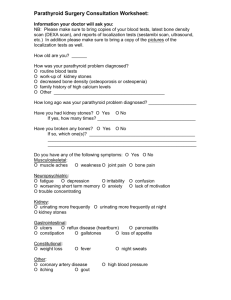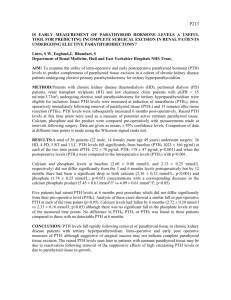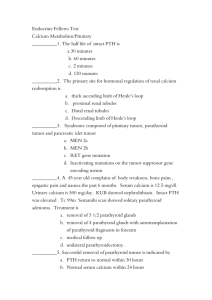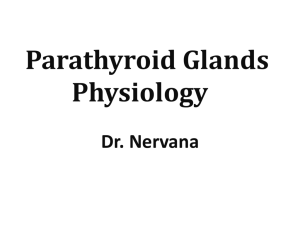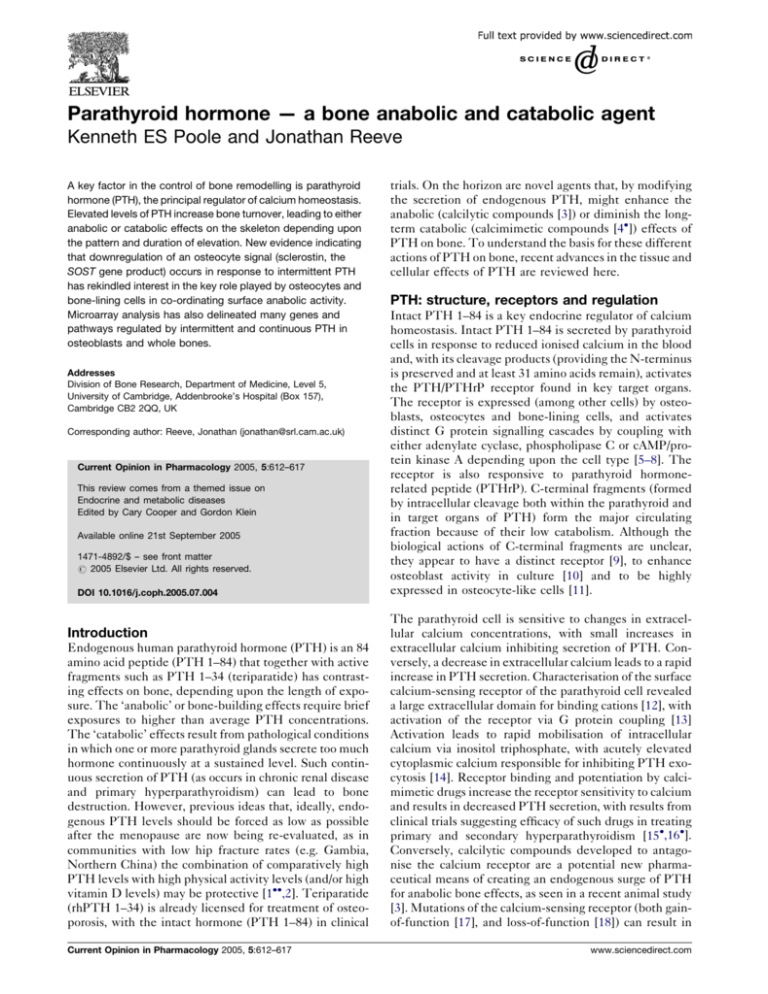
Parathyroid hormone — a bone anabolic and catabolic agent
Kenneth ES Poole and Jonathan Reeve
A key factor in the control of bone remodelling is parathyroid
hormone (PTH), the principal regulator of calcium homeostasis.
Elevated levels of PTH increase bone turnover, leading to either
anabolic or catabolic effects on the skeleton depending upon
the pattern and duration of elevation. New evidence indicating
that downregulation of an osteocyte signal (sclerostin, the
SOST gene product) occurs in response to intermittent PTH
has rekindled interest in the key role played by osteocytes and
bone-lining cells in co-ordinating surface anabolic activity.
Microarray analysis has also delineated many genes and
pathways regulated by intermittent and continuous PTH in
osteoblasts and whole bones.
Addresses
Division of Bone Research, Department of Medicine, Level 5,
University of Cambridge, Addenbrooke’s Hospital (Box 157),
Cambridge CB2 2QQ, UK
Corresponding author: Reeve, Jonathan (jonathan@srl.cam.ac.uk)
Current Opinion in Pharmacology 2005, 5:612–617
This review comes from a themed issue on
Endocrine and metabolic diseases
Edited by Cary Cooper and Gordon Klein
Available online 21st September 2005
1471-4892/$ – see front matter
# 2005 Elsevier Ltd. All rights reserved.
DOI 10.1016/j.coph.2005.07.004
Introduction
Endogenous human parathyroid hormone (PTH) is an 84
amino acid peptide (PTH 1–84) that together with active
fragments such as PTH 1–34 (teriparatide) has contrasting effects on bone, depending upon the length of exposure. The ‘anabolic’ or bone-building effects require brief
exposures to higher than average PTH concentrations.
The ‘catabolic’ effects result from pathological conditions
in which one or more parathyroid glands secrete too much
hormone continuously at a sustained level. Such continuous secretion of PTH (as occurs in chronic renal disease
and primary hyperparathyroidism) can lead to bone
destruction. However, previous ideas that, ideally, endogenous PTH levels should be forced as low as possible
after the menopause are now being re-evaluated, as in
communities with low hip fracture rates (e.g. Gambia,
Northern China) the combination of comparatively high
PTH levels with high physical activity levels (and/or high
vitamin D levels) may be protective [1,2]. Teriparatide
(rhPTH 1–34) is already licensed for treatment of osteoporosis, with the intact hormone (PTH 1–84) in clinical
Current Opinion in Pharmacology 2005, 5:612–617
trials. On the horizon are novel agents that, by modifying
the secretion of endogenous PTH, might enhance the
anabolic (calcilytic compounds [3]) or diminish the longterm catabolic (calcimimetic compounds [4]) effects of
PTH on bone. To understand the basis for these different
actions of PTH on bone, recent advances in the tissue and
cellular effects of PTH are reviewed here.
PTH: structure, receptors and regulation
Intact PTH 1–84 is a key endocrine regulator of calcium
homeostasis. Intact PTH 1–84 is secreted by parathyroid
cells in response to reduced ionised calcium in the blood
and, with its cleavage products (providing the N-terminus
is preserved and at least 31 amino acids remain), activates
the PTH/PTHrP receptor found in key target organs.
The receptor is expressed (among other cells) by osteoblasts, osteocytes and bone-lining cells, and activates
distinct G protein signalling cascades by coupling with
either adenylate cyclase, phospholipase C or cAMP/protein kinase A depending upon the cell type [5–8]. The
receptor is also responsive to parathyroid hormonerelated peptide (PTHrP). C-terminal fragments (formed
by intracellular cleavage both within the parathyroid and
in target organs of PTH) form the major circulating
fraction because of their low catabolism. Although the
biological actions of C-terminal fragments are unclear,
they appear to have a distinct receptor [9], to enhance
osteoblast activity in culture [10] and to be highly
expressed in osteocyte-like cells [11].
The parathyroid cell is sensitive to changes in extracellular calcium concentrations, with small increases in
extracellular calcium inhibiting secretion of PTH. Conversely, a decrease in extracellular calcium leads to a rapid
increase in PTH secretion. Characterisation of the surface
calcium-sensing receptor of the parathyroid cell revealed
a large extracellular domain for binding cations [12], with
activation of the receptor via G protein coupling [13]
Activation leads to rapid mobilisation of intracellular
calcium via inositol triphosphate, with acutely elevated
cytoplasmic calcium responsible for inhibiting PTH exocytosis [14]. Receptor binding and potentiation by calcimimetic drugs increase the receptor sensitivity to calcium
and results in decreased PTH secretion, with results from
clinical trials suggesting efficacy of such drugs in treating
primary and secondary hyperparathyroidism [15,16].
Conversely, calcilytic compounds developed to antagonise the calcium receptor are a potential new pharmaceutical means of creating an endogenous surge of PTH
for anabolic bone effects, as seen in a recent animal study
[3]. Mutations of the calcium-sensing receptor (both gainof-function [17], and loss-of-function [18]) can result in
www.sciencedirect.com
Parathyroid hormone — a bone anabolic and catabolic agent Poole and Reeve 613
either autosomal dominant hypocalcaemia [17] or familial
hypocalciuric hypercalcaemia [18].
The principal target organs for PTH are the kidney
(increasing proximal tubular resorption of calcium, phosphate excretion and 1,25 dihydroxyvitamin D formation)
and the skeleton. An indirect effect, increasing intestinal
calcium absorption, is mediated by the increase in 1,25
dihydroxyvitamin D formation in the kidney. Intact PTH
administration results in a rapid increase in biochemical
markers of bone formation, with a lesser and delayed
increase in resorption markers [19]; the same response is
seen following treatment with teriparatide [20]. Hodsman
and Steer [21] found histomorphometric evidence of
osteoblast accumulation in response to teriparatide injections within six weeks. Histomorphometry has demonstrated improved trabecular thickness [22] and
connectivity [23] in response to teriparatide, whereas
others have found increased osteonal thickness
[22,24,25], as well as evidence of periosteal and endosteal
new bone formation [25,26]. Initial fears of increased
cortical porosity were not borne out by clinical studies,
with cortical thickness remaining higher than controls
after treatment [24]. Indeed, densitometry studies of
treated patients confirmed (indirectly) that treatment
increased sub-periosteal bone formation in the distal
radius [27] or cortical thickness in the femoral neck [28].
The anabolic responses of osteoblasts to PTH have been
studied intensively, with reports of enhanced recruitment, proliferation and differentiation and reduced osteoblast apoptosis thought to be key regulatory components.
Emerging technology, such as microarray chips, is casting
new light on the complex mechanisms underlying the
dichotomous anabolic and catabolic actions of PTH on
bone cells in vitro [29] and in vivo [30]. Onyia et al. [30]
used microarray analysis of mRNA from the distal femur
of rats treated with either intermittent or continuous
teriparatide to profile changes in gene expression in
response to the two regimes [30]. Although 22 genes
were co-regulated, a further 19 genes were regulated by
intermittent teriparatide and 173 by continuous treatment [30]. Gene regulation in cultured osteoblast-like
cells was equally complex [29]. Several gene expression
responses to intermittent PTH were shown in mouse
genetic studies, such as those involving Cbfa-1 [31] and
c-fos [32]. Despite the limitations of in vitro systems,
osteoblastic cells could be stimulated to differentiate
by intermittent teriparatide, whereas continuous PTH
inhibited their differentiation [33]. That local insulin-like
growth factor-1 production mediated the stimulatory
effects of intermittent PTH in cultured osteoblast-like
cells [34,35] was confirmed in vivo using rats [36] and mice
[37].
Jilka et al. [38] showed that intermittent PTH could
inhibit osteoblast (and osteocyte) apoptosis in vivo and
www.sciencedirect.com
in vitro, the effects of which would be to prolong the
effective lifespan of osteoblasts. It seems increasingly
likely that the mechanism of action of PTH is a coordinated one involving cells in addition to active osteoblasts,
such as osteocytes and bone-lining cells [11]. De novo
bone formation on previously quiescent surfaces
(‘renewed modelling’) without evidence of cellular proliferation led Dobnig and Turner [39] to conclude that the
lining cell could revert to an active osteoblast phenotype
at the initiation of intermittent teriparatide therapy, views
supported by histological evaluation [21,40]. The rapidity
(within 28 days) of histological changes of new bone
formation in response to intermittent PTH therapy suggests (by exclusion) that ‘renewed modelling’ occurs
initially at key sites such as the periosteum [41]. Osteocytes have been shown recently to rapidly downregulate
sclerostin, a key osteoblast inhibitory protein, in response
to intermittent PTH [42]. Poole et al. [43] suggested
that the widespread osteocytic expression of sclerostin
observed in human bone was responsible for maintaining
lining cells in a quiescent state on bone surfaces. A
decrease in osteocytic sclerostin production in response
to PTH should allow formation of new bone on previously
quiescent surfaces (as lining cells revert to an active boneforming state).
Less is known of the mechanisms whereby continuous
PTH is catabolic to bone. Frolik et al. [44] found that the
response of bone to PTH was determined principally by
pharmacokinetics, with the amount of time each day that
teriparatide concentrations in serum were above baseline
levels of endogenous PTH in rats determining the anabolic or catabolic response, rather than the area under the
curve or Cmax of teriparatide achieved. Several recent
studies suggest that continuous (but not intermittent)
PTH can result in an increase in receptor activator of
nuclear factor-kB ligand (RANKL) expression and consequent osteoclastogenesis in culture, with an associated
inhibitory effect on osteoprotegerin expression [35,45].
Therapy with analogs of PTH
It is now possible to synthesize either the whole PTH
molecule or specific fragments by recombinant technology. Initial studies with PTH, however, used PTH 1–34
(teriparatide) as it was thought to be similar to the natural
cleavage product and retained the bioactivity of PTH 1–
84 in bioassay. More recent studies with PTH 1–38 [46],
PTH 1–84 [19] and PTHrP 1–36 [47] have suggested
potential new applications with fragments of different
structure, which is particularly intriguing given the distinct actions of the C-terminal fragment present in PTH
1–84 [19]. The majority of clinical studies with PTH as a
treatment for osteoporosis have involved parenteral
administration; however, in one study, PTH 1–34 was
delivered by direct plasmid gene incorporation of PTH 1–
34 and expression by fibroblasts for the in vivo treatment
of bone defects [48]. The bone anabolic effects of terCurrent Opinion in Pharmacology 2005, 5:612–617
614 Endocrine and metabolic diseases
iparatide were first reported in an isotopic tracer and
balance study of four postmenopausal women in 1976
[49]. Four years later, the first multicentre trial results
confirmed the anabolic actions of PTH 1–34 in 21 patients
[50], with histological evidence for increased cancellous
bone volume, new bone formation and dissociated bone
resorption and formation rates observed in women administered teriparatide for 6–24 months [50]. It was 21 years
later that a sufficiently large (n=1637) randomized control
trial proved the anti-fracture efficacy of teriparatide at
reducing both vertebral and non-vertebral fracture risk in
osteoporotic women [51]. The reduction in risk of new
vertebral fractures was 65% using once-daily 20 mg injections, with an even greater risk reduction for moderate-tosevere fractures (90%) [51]. This reduction in relative risk
was independent of age and the initial severity of osteoporosis in women (based on prevalent baseline vertebral
fractures and bone mineral density [BMD]) [52]. Secondary outcome measures in this and other trials of teriparatide confirmed that BMD increased during 18 months of
therapy at the lumbar spine and the femoral neck, but fell
slightly at the radius. Nevertheless, the relative risk of
wrist fractures in treated subjects was significantly lower
than in controls [51]. BMD changes of a similar magnitude were observed in studies of men treated with teriparatide [53].
Phase II studies in postmenopausal women with osteoporosis have been reported using recombinant PTH 1–84
(full-length or intact PTH). Hodsman et al. [19] showed
that daily doses of 100 mg of PTH 1–84 enhanced lumbar
spine BMD by 7.8% at 12 months, with a lesser (0.5%)
increment at the femoral neck.
One consequence of daily administration of teriparatide
and PTH 1–84 is an increased incidence of transient
hypercalcaemia. This led to only one withdrawal from
therapy in the trial of Neer et al. [51] (out of a total of 541
patients receiving the marketed 20 mg daily dose).
Although the incidence of post-dose transient hypercalcaemia was slightly higher in Phase II studies of PTH 1–
84, only one subject was withdrawn from the treatment
arm as a result [19].
There is great interest in the selection criteria by which
osteoporotic patients are chosen to receive PTH analogues, and at what stage in the prevention of fractures
anabolic agents such as teriparatide should be employed.
This is in addition to concerns regarding the efficacy of
using teriparatide in patients previously exposed to antiresorptive therapy. In the UK, National Health Service
guidance is based on a health economic model in which
no advantage is assumed over bisphosphonates for the
majority of patients [54]. Thus PTH is reserved for ‘nonresponders’ or those intolerant of bisphosphonates. In one
study in which postmenopausal women received teriparatide therapy with alendronate (an oral bisphosphonate),
Current Opinion in Pharmacology 2005, 5:612–617
the biochemical response was similar to that seen in
bisphosphonate-naive subjects (albeit in small groups
of subjects treated for short periods) [55]. However, in
other studies using bone markers and densitometry, previous or concurrent therapy with a bisphosphonate in
osteoporotic patients impaired the anabolic response to
either teriparatide [56,57] or PTH 1–84 [58].
Finally, as teriparatide is typically administered for 18
months, it is not clear whether antiresorptive agents (e.g.
bisphosphonates or selective estrogen receptor modulators such as raloxifene) should be commenced at the
cessation of treatment. BMD can fall after teriparatide
therapy ceases, although fractures do not demonstrably
increase as a result [59,60]. One option might be to
administer oral bisphosphonates after PTH therapy has
ceased, although fracture data are not yet available to
critique this approach. Using alendronate after PTH
resulted in further increases in spine and femoral neck
BMD in men [60] and postmenopausal women [61,62].
Conclusions
The mechanisms by which intermittent PTH is anabolic,
whereas continuous exposure to raised PTH is detrimental to the skeleton, are being elucidated. New techniques
such as microarray analysis have confirmed the complexity of the mechanisms involved. Increased understanding
of the anabolic effects of PTH and its analogues should
result in an increased number of therapeutic targets. For
example, increased understanding of the mechanisms
whereby PTH modulates osteocyte sclerostin signalling
activity should encourage the development of new and
highly targeted anabolic treatments for osteoporosis.
Update
In contrast to Keller and Kneissel’s work [42] on a
classical mouse calvarial model of PTH-stimulated bone
formation, Bellido et al. [63] have shown recently that
continuous PTH (at levels 60-fold above physiological
levels) administered via a pump produced a reduction in
SOST expression in mouse lumbar vertebrae of greater
duration and magnitude than did short-term intermittent
dosing. This work is useful in confirming earlier work that
the SOST gene in osteocytes (and its protein product,
sclerostin) is a target of PTH in mice.
Acknowledgements
KES Poole was supported by a MRC Clinical Research Training
Fellowship.
References and recommended reading
Papers of particular interest, published within the annual period of
review, have been highlighted as:
of special interest
of outstanding interest
1.
Aspray TJ, Yan L, Prentice A: Parathyroid hormone and rates of
bone formation are raised in perimenopausal rural Gambian
women. Bone 2005, 36:710-720.
www.sciencedirect.com
Parathyroid hormone — a bone anabolic and catabolic agent Poole and Reeve 615
Emerging evidence that high endogenous PTH is not necessarily detrimental to bone in women from the Gambia. High endogenous PTH levels
are present in women from a population with a very low incidence of hip
fracture.
2.
3.
Yan L, Zhou B, Wang X, D’Ath S, Laidlaw A, Laskey MA, Prentice A:
Older people in China and the United Kingdom differ in the
relationships among parathyroid hormone, vitamin D, and
bone mineral status. Bone 2003, 33:620-627.
Gowen M, Stroup GB, Dodds RA, James IE, Votta BJ, Smith BR,
Bhatnagar PK, Lago AM, Callahan JF, DelMar EG et al.:
Antagonizing the parathyroid calcium receptor stimulates
parathyroid hormone secretion and bone formation in
osteopenic rats. J Clin Invest 2000, 105:1595-1604.
4. Steddon SJ, Cunningham J: Calcimimetics and calcilytics–
fooling the calcium receptor. Lancet 2005, 365:2237-2239.
A recent review of therapeutic strategies (both calcimimetic and calcilytic)
to influence the calcium-sensing receptor.
5.
6.
7.
Schwindinger WF, Fredericks J, Watkins L, Robinson H,
Bathon JM, Pines M, Suva LJ, Levine MA: Coupling of the
PTH/PTHrP receptor to multiple G-proteins. Direct
demonstration of receptor activation of Gs, Gq/11, and Gi(1)
by [alpha-32P]GTP-gamma-azidoanilide photoaffinity
labeling. Endocrine 1998, 8:201-209.
Cheung R, Erclik MS, Mitchell J: Increased expression of
G(11)alpha in osteoblastic cells enhances parathyroid
hormone activation of phospholipase C and AP-1 regulation of
matrix metalloproteinase-13 mRNA. J Cell Physiol 2005,
204:336-343.
Kondo H, Guo J, Bringhurst FR: Cyclic adenosine
monophosphate/protein kinase A mediates parathyroid
hormone/parathyroid hormone-related protein receptor
regulation of osteoclastogenesis and expression of RANKL
and osteoprotegerin mRNAs by marrow stromal cells.
J Bone Miner Res 2002, 17:1667-1679.
8.
Bringhurst FR: PTH receptors and apoptosis in osteocytes.
J Musculoskelet Neuronal Interact 2002, 2:245-251.
9.
Nguyen-Yamamoto L, Rousseau L, Brossard JH, Lepage R,
D’Amour P: Synthetic carboxyl-terminal fragments of
parathyroid hormone (PTH) decrease ionized calcium
concentration in rats by acting on a receptor different from the
PTH/PTH-related peptide receptor. Endocrinology 2001,
142:1386-1392.
10. Sutherland MK, Rao LG, Wylie JN, Gupta A, Ly H, Sodek J,
Murray TM: Carboxyl-terminal parathyroid hormone peptide
(53-84) elevates alkaline phosphatase and osteocalcin mRNA
levels in SaOS-2 cells. J Bone Miner Res 1994, 9:453-458.
patients with CKD not receiving dialysis. Am J Kidney Dis 2005,
46:58-67.
An 18-week Phase II randomized, double-blind, placebo-controlled study
into the effects of titrated doses of cinacalcet in patients with chronic
kidney disease.
17. Pollak MR, Brown EM, Chou YH, Hebert SC, Marx SJ,
Steinmann B, Levi T, Seidman CE, Seidman JG: Mutations in the
human Ca(2+)-sensing receptor gene cause familial
hypocalciuric hypercalcemia and neonatal severe
hyperparathyroidism. Cell 1993, 75:1297-1303.
18. Pollak MR, Chou YH, Marx SJ, Steinmann B, Cole DE, Brandi ML,
Papapoulos SE, Menko FH, Hendy GN, Brown EM et al.: Familial
hypocalciuric hypercalcemia and neonatal severe
hyperparathyroidism. Effects of mutant gene dosage on
phenotype. J Clin Invest 1994, 93:1108-1112.
19. Hodsman AB, Hanley DA, Ettinger MP, Bolognese MA, Fox J,
Metcalfe AJ, Lindsay R: Efficacy and safety of human
parathyroid hormone-(1-84) in increasing bone mineral
density in postmenopausal osteoporosis. J Clin Endocrinol
Metab 2003, 88:5212-5220.
20. Hodsman AB, Fraher LJ, Ostbye T, Adachi JD, Steer BM: An
evaluation of several biochemical markers for bone formation
and resorption in a protocol utilizing cyclical parathyroid
hormone and calcitonin therapy for osteoporosis. J Clin Invest
1993, 91:1138-1148.
21. Hodsman AB, Steer BM: Early histomorphometric changes in
response to parathyroid hormone therapy in osteoporosis:
evidence for de novo bone formation on quiescent cancellous
surfaces. Bone 1993, 14:523-527.
22. Bradbeer JN, Arlot ME, Meunier PJ, Reeve J: Treatment of
osteoporosis with parathyroid peptide (hPTH 1-34) and
oestrogen: increase in volumetric density of iliac cancellous
bone may depend on reduced trabecular spacing as well as
increased thickness of packets of newly formed bone.
Clin Endocrinol (Oxf) 1992, 37:282-289.
23. Jiang Y, Zhao JJ, Mitlak BH, Wang O, Genant HK, Eriksen EF:
Recombinant human parathyroid hormone (1-34)
[teriparatide] improves both cortical and cancellous bone
structure. J Bone Miner Res 2003, 18:1932-1941.
24. Hodsman AB, Kisiel M, Adachi JD, Fraher LJ, Watson PH:
Histomorphometric evidence for increased bone turnover
without change in cortical thickness or porosity after 2 years
of cyclical hPTH(1-34) therapy in women with severe
osteoporosis. Bone 2000, 27:311-318.
11. Divieti P, Inomata N, Chapin K, Singh R, Juppner H, Bringhurst FR:
Receptors for the carboxyl-terminal region of pth(1-84) are
highly expressed in osteocytic cells. Endocrinology 2001,
142:916-925.
25. Dempster DW, Cosman F, Kurland ES, Zhou H, Nieves J,
Woelfert L, Shane E, Plavetic K, Muller R, Bilezikian J et al.:
Effects of daily treatment with parathyroid hormone on
bone microarchitecture and turnover in patients with
osteoporosis: a paired biopsy study. J Bone Miner Res 2001,
16:1846-1853.
12. Brown EM, Gamba G, Riccardi D, Lombardi M, Butters R, Kifor O,
Sun A, Hediger MA, Lytton J, Hebert SC: Cloning and
characterization of an extracellular Ca(2+)-sensing receptor
from bovine parathyroid. Nature 1993, 366:575-580.
26. Oxlund H, Ejersted C, Andreassen TT, Torring O, Nilsson MH:
Parathyroid hormone (1-34) and (1-84) stimulate cortical bone
formation both from periosteum and endosteum. Calcif Tissue
Int 1993, 53:394-399.
13. Brown EM, MacLeod RJ: Extracellular calcium sensing
and extracellular calcium signaling. Physiol Rev 2001,
81:239-297.
27. Zanchetta JR, Bogado CE, Ferretti JL, Wang O, Wilson MG,
Sato M, Gaich GA, Dalsky GP, Myers SL: Effects of teriparatide
[recombinant human parathyroid hormone (1-34)] on cortical
bone in postmenopausal women with osteoporosis. J Bone
Miner Res 2003, 18:539-543.
14. Nemeth EF, Scarpa A: Rapid mobilization of cellular Ca2+ in
bovine parathyroid cells evoked by extracellular divalent
cations. Evidence for a cell surface calcium receptor.
J Biol Chem 1987, 262:5188-5196.
15. Peacock M, Bilezikian JP, Klassen PS, Guo MD, Turner SA,
Shoback D: Cinacalcet hydrochloride maintains long-term
normocalcemia in patients with primary hyperparathyroidism.
J Clin Endocrinol Metab 2005, 90:135-141.
Multicenter, randomized, double-blind, placebo-controlled study into the
use of cinacalcet (a calcimimetic) to reduce serum calcium in primary
hyperparathyroidism.
16. Charytan C, Coburn JW, Chonchol M, Herman J, Lien YH, Liu W,
Klassen PS, McCary LC, Pichette V: Cinacalcet hydrochloride is
an effective treatment for secondary hyperparathyroidism in
www.sciencedirect.com
28. Uusi-Rasi K, Semanick LM, Zanchetta JR, Bogado CE, Eriksen EF,
Sato M, Beck TJ: Effects of teriparatide [rhPTH (1-34)]
treatment on structural geometry of the proximal femur in
elderly osteoporotic women. Bone 2005, 36:948-958.
Evaluation of changes in femoral neck geometry (using hip strength
analysis) in response to teriparatide treatment. Teriparatide increased
cortical thickness and axial and bending strength at the femoral narrow
neck and trochanter.
29. Qin L, Qiu P, Wang L, Li X, Swarthout JT, Soteropoulos P, Tolias P,
Partridge NC: Gene expression profiles and transcription
factors involved in parathyroid hormone signaling in
osteoblasts revealed by microarray and bioinformatics.
J Biol Chem 2003, 278:19723-19731.
Current Opinion in Pharmacology 2005, 5:612–617
616 Endocrine and metabolic diseases
30. Onyia JE, Helvering LM, Gelbert L, Wei T, Huang S, Chen P,
Dow ER, Maran A, Zhang M, Lotinun S et al.: Molecular profile of
catabolic versus anabolic treatment regimens of parathyroid
hormone (PTH) in rat bone: an analysis by DNA microarray.
J Cell Biochem 2005, 95:403-418.
Intermittent and continuous PTH regulated 22 genes in the distal femoral
metaphysis of the femur in rats. Intermittent PTH regulated 19 additional
genes and contiunous PTH regulated 173 additional genes, as established by microarray analysis.
31. Krishnan V, Moore TL, Ma YL, Helvering LM, Frolik CA,
Valasek KM, Ducy P, Geiser AG: Parathyroid hormone bone
anabolic action requires Cbfa1/Runx2-dependent signaling.
Mol Endocrinol 2003, 17:423-435.
32. Demiralp B, Chen HL, Koh AJ, Keller ET, McCauley LK: Anabolic
actions of parathyroid hormone during bone growth are
dependent on c-fos. Endocrinology 2002, 143:4038-4047.
33. Ishizuya T, Yokose S, Hori M, Noda T, Suda T, Yoshiki S,
Yamaguchi A: Parathyroid hormone exerts disparate effects on
osteoblast differentiation depending on exposure time in rat
osteoblastic cells. J Clin Invest 1997, 99:2961-2970.
34. Canalis E, Centrella M, Burch W, McCarthy TL: Insulin-like
growth factor I mediates selective anabolic effects of
parathyroid hormone in bone cultures. J Clin Invest 1989,
83:60-65.
35. Locklin RM, Khosla S, Turner RT, Riggs BL: Mediators of the
biphasic responses of bone to intermittent and continuously
administered parathyroid hormone. J Cell Biochem 2003,
89:180-190.
36. Watson P, Lazowski D, Han V, Fraher L, Steer B, Hodsman A:
Parathyroid hormone restores bone mass and enhances
osteoblast insulin-like growth factor I gene expression in
ovariectomized rats. Bone 1995, 16:357-365.
37. Bikle DD, Sakata T, Leary C, Elalieh H, Ginzinger D, Rosen CJ,
Beamer W, Majumdar S, Halloran BP: Insulin-like growth factor I
is required for the anabolic actions of parathyroid hormone on
mouse bone. J Bone Miner Res 2002, 17:1570-1578.
38. Jilka RL, Weinstein RS, Bellido T, Roberson P, Parfitt AM,
Manolagas SC: Increased bone formation by prevention of
osteoblast apoptosis with parathyroid hormone. J Clin Invest
1999, 104:439-446.
39. Dobnig H, Turner RT: Evidence that intermittent treatment
with parathyroid hormone increases bone formation in adult
rats by activation of bone lining cells. Endocrinology 1995,
136:3632-3638.
40. Leaffer D, Sweeney M, Kellerman LA, Avnur Z, Krstenansky JL,
Vickery BH, Caulfield JP: Modulation of osteogenic cell
ultrastructure by RS-23581, an analog of human parathyroid
hormone (PTH)-related peptide-(1-34), and bovine PTH-(1-34).
Endocrinology 1995, 136:3624-3631.
41. Parfitt AM: Parathyroid hormone and periosteal bone
expansion. J Bone Miner Res 2002, 17:1741-1743.
42. Keller H, Kneissel M: SOST is a target gene for PTH in bone.
Bone 2005, 37:148-158.
In vivo (mouse calvarial model of bone formation) and in vitro evidence for
rapid downregulation of SOST mRNA in response to PTH. Sclerostin, the
SOST gene product, has recently been shown to inhibit active osteoblasts by binding LRP-5 and -6.
43. Poole KES, van Bezooijen RL, Loveridge N, Hamersma H,
Papapoulos S, Lowik CW, Reeve J: Sclerostin is a delayed
secreted product of osteocytes that inhibits bone formation.
FASEB J 2005. [doi: 10.1096/fj.05-4221fje].
Sclerostin, the SOST gene product, was expressed exclusively in osteocytes in human iliac bone, as shown by immunohistochemistry. However,
new osteocytes only expressed the protein after the surrounding matrix
was mineralised.
44. Frolik CA, Black EC, Cain RL, Satterwhite JH, Brown-Augsburger
PL, Sato M, Hock JM: Anabolic and catabolic bone effects of
human parathyroid hormone (1-34) are predicted by duration
of hormone exposure. Bone 2003, 33:372-379.
45. Ma YL, Cain RL, Halladay DL, Yang X, Zeng Q, Miles RR,
Chandrasekhar S, Martin TJ, Onyia JE: Catabolic effects of
Current Opinion in Pharmacology 2005, 5:612–617
continuous human PTH (1-38) in vivo is associated with
sustained stimulation of RANKL and inhibition of
osteoprotegerin and gene-associated bone formation.
Endocrinology 2001, 142:4047-4054.
46. Hodsman AB, Steer BM, Fraher LJ, Drost DJ: Bone densitometric
and histomorphometric responses to sequential human
parathyroid hormone (1-38) and salmon calcitonin in
osteoporotic patients. Bone Miner 1991, 14:67-83.
47. Stewart AF: PTHrP(1-36) as a skeletal anabolic agent for the
treatment of osteoporosis. Bone 1996, 19:303-306.
48. Bonadio J, Smiley E, Patil P, Goldstein S: Localized, direct
plasmid gene delivery in vivo: prolonged therapy results in
reproducible tissue regeneration. Nat Med 1999, 5:753-759.
49. Reeve J, Hesp R, Williams D, Hulme P, Klenerman L, Zanelli JM,
Darby AJ, Tregear GW, Parsons JA: Anabolic effect of low doses
of a fragment of human parathyroid hormone on the skeleton
in postmenopausal osteoporosis. Lancet 1976, 1:1035-1038.
50. Reeve J, Meunier PJ, Parsons JA, Bernat M, Bijvoet OL,
Courpron P, Edouard C, Klenerman L, Neer RM, Renier JC et al.:
Anabolic effect of human parathyroid hormone fragment on
trabecular bone in involutional osteoporosis: a multicentre
trial. Br Med J 1980, 280:1340-1344.
51. Neer RM, Arnaud CD, Zanchetta JR, Prince R, Gaich GA,
Reginster JY, Hodsman AB, Eriksen EF, Ish-Shalom S, Genant HK
et al.: Effect of parathyroid hormone (1-34) on fractures and
bone mineral density in postmenopausal women with
osteoporosis. N Engl J Med 2001, 344:1434-1441.
52. Marcus R, Wang O, Satterwhite J, Mitlak B: The skeletal
response to teriparatide is largely independent of age, initial
bone mineral density, and prevalent vertebral fractures in
postmenopausal women with osteoporosis. J Bone Miner Res
2003, 18:18-23.
53. Orwoll ES, Scheele WH, Paul S, Adami S, Syversen U,
Diez-Perez A, Kaufman JM, Clancy AD, Gaich GA: The effect
of teriparatide [human parathyroid hormone (1-34)] therapy
on bone density in men with osteoporosis. J Bone Miner Res
2003, 18:9-17.
54. National Institute for Clinical Excellence Technology Appraisal 87:
Bisphosphonates (alendronate, etidronate, risedronate),
selective oestrogen receptor modulators (raloxifene) and
parathyroid hormone (teriparatide) for the secondary
prevention of osteoporotic fragility fractures in
postmenopausal women. 2005 [URL: http://www.nice.org.uk/
pdf/TA087guidance.pdf].
55. Cosman F, Nieves J, Woelfert L, Shen V, Lindsay R: Alendronate
does not block the anabolic effect of PTH in postmenopausal
osteoporotic women. J Bone Miner Res 1998, 13:1051-1055.
56. Finkelstein JS, Hayes A, Hunzelman JL, Wyland JJ, Lee H,
Neer RM: The effects of parathyroid hormone, alendronate,
or both in men with osteoporosis. N Engl J Med 2003,
349:1216-1226.
57. Ettinger B, San Martin J, Crans G, Pavo I: Differential effects of
teriparatide on BMD after treatment with raloxifene or
alendronate. J Bone Miner Res 2004, 19:745-751.
58. Black DM, Greenspan SL, Ensrud KE, Palermo L, McGowan JA,
Lang TF, Garnero P, Bouxsein ML, Bilezikian JP, Rosen CJ: The
effects of parathyroid hormone and alendronate alone or in
combination in postmenopausal osteoporosis. N Engl J Med
2003, 349:1207-1215.
59. Lindsay R, Scheele WH, Neer R, Pohl G, Adami S, Mautalen C,
Reginster JY, Stepan JJ, Myers SL, Mitlak BH: Sustained
vertebral fracture risk reduction after withdrawal of
teriparatide in postmenopausal women with osteoporosis.
Arch Intern Med 2004, 164:2024-2030.
Follow-up of patients from the Fracture Prevention Trial after stopping
teriparatide revealed apparent prolongation of anti-vertebral fracture
efficacy. Patients could receive alternative osteoporosis therapies after
the trial, so this was an open unblinded study extension.
60. Kurland ES, Heller SL, Diamond B, McMahon DJ, Cosman F,
Bilezikian JP: The importance of bisphosphonate therapy in
maintaining bone mass in men after therapy with teriparatide
www.sciencedirect.com
Parathyroid hormone — a bone anabolic and catabolic agent Poole and Reeve 617
[human parathyroid hormone(1-34)]. Osteoporos Int 2004,
15:992-997.
Evidence from a small study in men showing that commencing anti-resorptive therapy immediately after teriparatide treatment preserves bone mass.
61. Black DM, Rosen CJ, Palermo L, Hue T, Ensrud KE, Greenspan SL,
Lang TF, McGowen JA, Bilezikian JP: The effect of 1 year of
alendronate following 1 year of PTH (PTH1-84): Second year
results from the PTH and alendronate (PaTH) trial [abstract].
Bone 2005, 36:S448-S449.
BMD (axial and volumetric) improvements were maintained or increased
in women with postmenopausal osteoporosis who were given alendronate (10 mg) daily for a year after a one-year treatment with PTH.
www.sciencedirect.com
62. Rittmaster RS, Bolognese M, Ettinger MP, Hanley DA,
Hodsman AB, Kendler DL, Rosen CJ: Enhancement of bone
mass in osteoporotic women with parathyroid hormone
followed by alendronate. J Clin Endocrinol Metab 2000,
85:2129-2134.
63. Bellido T, Ali AA, Gubrij I, Plotkin LI, Fu Q, O’Brien CA et al.:
Chronic elevation of PTH in mice reduces expression of
sclerostin by osteocytes: a novel mechanism for hormonal
control of osteoblastogenesis. Endocrinology 2005
[doi:10.1210/en.2005-0239; URL: http://endo.endojournals.org/
cgi/rapidpdf/en.2005-0239v1].
Current Opinion in Pharmacology 2005, 5:612–617


